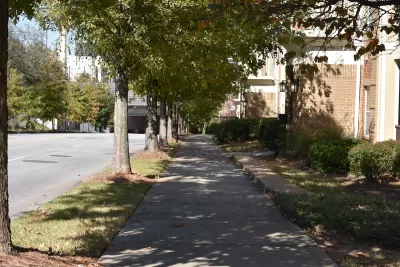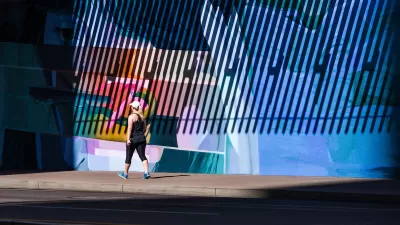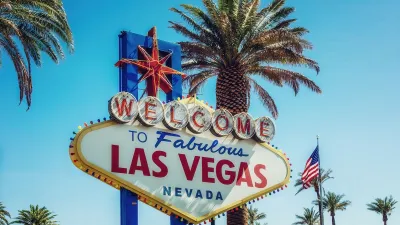New research suggests that cooling pavement treatments can actually make pedestrians standing on it feel hotter.

A popular new tool for cooling urban streets and sidewalks could have some unintended consequences, reports Linda Poon in Bloomberg CityLab. According to Poon’s article, “recent research in Phoenix has resurfaced a glaring tradeoff: The reflective coating can make pedestrians standing on the treated pavement feel even hotter.”
“When [professor V. Kelly Turner] and researchers at Arizona State University looked at the impacts of the first US program in Los Angeles, they found that around noon on a hot, dry day, a person standing on cool pavement could feel more than 7 degrees warmer than if they were to stand on uncoated asphalt. The mean radiant temperature, which is a measure of how humans experience the heat, fell in the afternoon but was still 3 degrees warmer.”
Those findings were reaffirmed by an Arizona State University study. However, Poon notes that “ASU’s study suggested minimal difference in mean radiant temperatures between sidewalks near traditional asphalt streets and those near reflective pavement,” meaning pedestrians walking on surfaces near coated streets but not directly on coated surfaces wouldn’t be affected.
For Turner, this points to a need to prioritize shade trees, a proven solution to urban heat, before trying more experimental solutions. But cooling pavement treatments have their place. By dramatically reducing surface temperatures, cool pavements can prevent burn injuries. “Perhaps a more pronounced effect of cool pavement technology that further appeals to cities is that it decreases thermal strain on the pavement, reducing cracking and helping extend its lifespan.” And one pavement treatment used in the Pacoima neighborhood of Los Angeles is showing promising results, with early research indicating that the treatment cools ambient temperature and doesn’t create glare in the same way as others.
Until more data on cool pavement coatings is available, experts believe cities should “carefully consider where to apply [them], and weigh both the costs and benefits alongside other interventions.”
FULL STORY: The Hottest Urban Heat Solution Comes With a Glaring Tradeoff

Alabama: Trump Terminates Settlements for Black Communities Harmed By Raw Sewage
Trump deemed the landmark civil rights agreement “illegal DEI and environmental justice policy.”

Planetizen Federal Action Tracker
A weekly monitor of how Trump’s orders and actions are impacting planners and planning in America.

The 120 Year Old Tiny Home Villages That Sheltered San Francisco’s Earthquake Refugees
More than a century ago, San Francisco mobilized to house thousands of residents displaced by the 1906 earthquake. Could their strategy offer a model for the present?

In Both Crashes and Crime, Public Transportation is Far Safer than Driving
Contrary to popular assumptions, public transportation has far lower crash and crime rates than automobile travel. For safer communities, improve and encourage transit travel.

Report: Zoning Reforms Should Complement Nashville’s Ambitious Transit Plan
Without reform, restrictive zoning codes will limit the impact of the city’s planned transit expansion and could exclude some of the residents who depend on transit the most.

Judge Orders Release of Frozen IRA, IIJA Funding
The decision is a victory for environmental groups who charged that freezing funds for critical infrastructure and disaster response programs caused “real and irreparable harm” to communities.
Urban Design for Planners 1: Software Tools
This six-course series explores essential urban design concepts using open source software and equips planners with the tools they need to participate fully in the urban design process.
Planning for Universal Design
Learn the tools for implementing Universal Design in planning regulations.
Clanton & Associates, Inc.
Jessamine County Fiscal Court
Institute for Housing and Urban Development Studies (IHS)
City of Grandview
Harvard GSD Executive Education
Toledo-Lucas County Plan Commissions
Salt Lake City
NYU Wagner Graduate School of Public Service





























